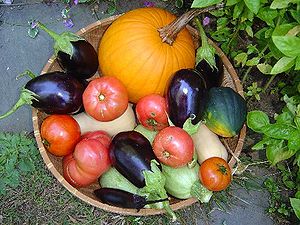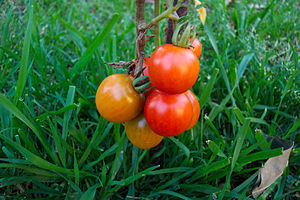Last year, I loved my CSA so much that I joined two this year! I am splitting them with a couple I know who was also interested, and I’m glad, because I am single, and though I love vegetables, I am practically overwhelmed, even after dividing both of my shares in half!
 Image via WikipediaI’ve been interested in the CSA concept for years. It seems like such an amazingly common-sense, yet innovative idea. You get fresh, healthy, locally grown (and often organic) foods, often at a lower price than what you would find at the supermarket. The farmer gets a built-in market, and usually they get paid at the beginning of the season, when they need it most. And you are helping out the environment by eating locally grown rather than having foods shipped in from other areas (or even other countries), as well as supporting small farms that tend to operate more sustainably and take better care of the soil & water they use.
Image via WikipediaI’ve been interested in the CSA concept for years. It seems like such an amazingly common-sense, yet innovative idea. You get fresh, healthy, locally grown (and often organic) foods, often at a lower price than what you would find at the supermarket. The farmer gets a built-in market, and usually they get paid at the beginning of the season, when they need it most. And you are helping out the environment by eating locally grown rather than having foods shipped in from other areas (or even other countries), as well as supporting small farms that tend to operate more sustainably and take better care of the soil & water they use.The problem was, I didn’t know how to find a CSA, or if there even were any in my area. I searched online a few times several years ago, but didn’t have much luck. But in the few years since then, the farming community has embraced the use of the internet, and many farms now have their own websites, which makes it much easier to find participating programs. There are at least 5 or 6 CSAs that deliver locally to my hometown now, and several others in outlying areas in the vicinity.
I’ve told many friends about it, and for the general public, the community supported agriculture concept seems to be a well-kept secret. For those who are unfamiliar with the idea, it is somewhat like a co-op. Individuals subscribe by purchasing a “share” of a given farm’s (or group of farms) harvest for the year. Usually this is done before the start of the season, so you make a one-time payment, and then collect your shares weekly or monthly throughout the harvest season.
Traditionally the concept has been mostly done with vegetables. However, there are all kinds of CSAs cropping up these days, from vegetables & fruits, to dairy and even meats. Here in Ohio, where the growing season is not that long, I subscribe to a vegetable CSA in the summer, and a meat CSA (with one of the same farms) in the winter months, so at least I know I am eating locally in part throughout the year.
One of the farms I am subscribed to is organic. The other has mostly naturally grown produce, except for the fruit. One share I pick up at a local farmer’s market. The other is delivered right to my office!
Right now I am overwhelmed with the summer’s bounty. My refrigerator is filled to overflowing with amazing, fresh vegetables (and my freezer still contains some organic meats from the winter share). It’s been years since I lived on a farm, and with all the years of shopping at supermarkets and just picking up whatever I felt like, I had forgotten what a bounty the summer truly brings…. It makes me feel so much more connected to my environment to only be eating things that are in season. It also forces me to cook more creatively!
Right now, in my fridge I have turnips, turnip greens, sweet corn, green beans, red cabbage, white cabbage, red onions, white onions, tomatoes, cucumbers, green peppers, three kind of hot peppers, eggplant, summer squash, patty-pan squash, zucchini, broccoli, cantaloupe, and honeydew melon…and probably some other things I’m forgetting. And all of it is organic or naturally grown, and was picked within the last 2 days.
I feel truly blessed. And I am happy to feel like I am contributing to helping others as well — not just the farmers I have come to call friends, but those who use our limited resources and will inhabit our beautiful planet in the future.
I encourage you to look up a CSA in your area today, and see how easy (and delicious!) it is to start making a difference.
For more info on CSAs, as well as my favorite resource for finding local farms in your area, visit our website at http://www.newholisticliving.com/csa.html
Happy eating!




